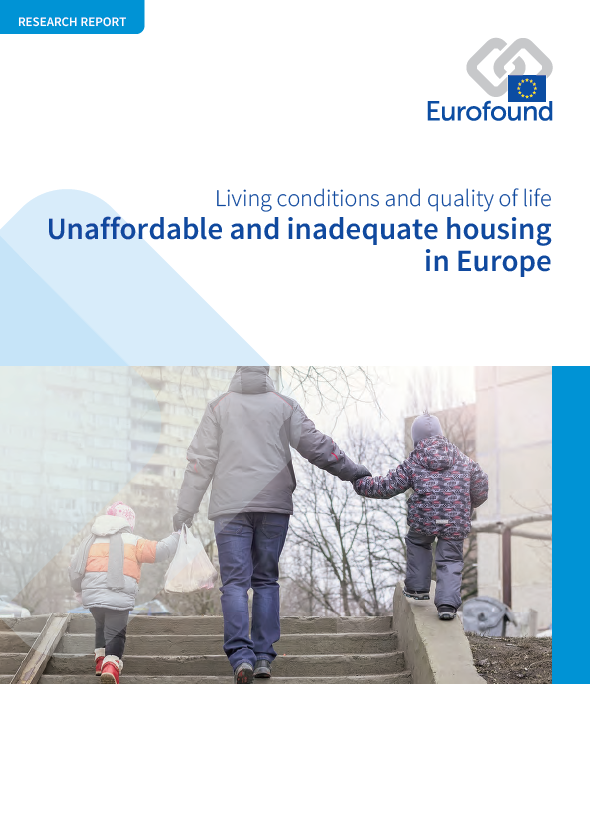
Unaffordable housing is a matter of great concern in the EU. It leads to homelessness, housing insecurity, financial strain and inadequate housing. It also prevents young people from leaving their family home. These problems affect people’s health and well-being, embody unequal living conditions and opportunities, and result in healthcare costs, reduced productivity and environmental damage. Private tenants have faced particularly large housing cost increases, and owners with mortgages are vulnerable to interest rate increases. In addition, many owners without mortgages, especially in post-communist and southern European countries, experience poverty and housing inadequacy. The cost-of-living crisis affects people in all tenancies. Social housing and rent subsidies support many, but capacity differs across and within countries, and these measures exclude certain groups in vulnerable situations and fail to reach everyone who is entitled to them. Three quarters of Member States have Housing First initiatives – providing housing for homeless people – but these mostly operate on a small scale. This report maps housing problems in the EU and the policies that address them, drawing on Eurofound’s Living, working and COVID-19 e-survey, European Union Statistics on Income and Living Conditions and input from the Network of Eurofound Correspondents.
Key findings
- Housing support, such as social housing and rent subsidies, is contributing to greater resilience and social protection for many people in the EU. It is crucial that policymakers consider the contribution of such support when shaping benefit reforms as housing benefits can provide immediate protection in emerging crises when determined by real housing costs, including energy costs and income.
- It is critical that housing policies aimed at improving housing affordability do not inadvertently exacerbate inequalities. Policies to increase housing affordability can have complex impacts that may not always improve access to housing and enhance quality of life. For example, housing benefits may drive up rent and purchase prices, and ownership support often benefits people with higher income more than those with lower incomes, often encouraging borrowers to take on mortgages they cannot pay back.
- It is essential for policymakers to consider groups in vulnerable situations in all tenures. For example, findings show that 46% of private rental market tenants feel at risk of leaving their home in the next three months because they can no longer afford it and in most of the countries where over half the population are homeowners without a mortgage, around one quarter are still at risk of poverty.
- Housing First policies are largely successful in keeping people out of homelessness and need to be scaled up across the EU. It is critical that such housing be independent, stable and truly unconditional on engagement with support services to ensure that access to housing is guaranteed.
- Funds to improve the energy efficiency of homes need to reach low-income groups, protecting them from future energy price increases. Findings show that 28% of people in the EU anticipated facing difficulties paying utility bills and this jumped to 36% for social tenants and homeowners without a mortgage in the bottom half of the income distribution – where many cannot maintain their homes at adequate temperature – underlining how current and future needs of inhabitants must be considered when improving housing adequacy.
The report contains the following table and figures.
- Table 1: Examples of Housing First-inspired policies and initiatives in EU Member States
- Figure 1: A framework for housing affordability and problems
- Figure 2: Distribution of population by type of tenure, EU Member States, 2020 (%)
- Figure 3: Distribution of population by dwelling type, EU Member States, 2020 (%)
- Figure 4: Housing costs, EU Member States, 2010 and 2019 (monthly purchasing power standard)
- Figure 5: Housing costs: Rents, prices and interest rates, EU27, 2005–2023 (indexed, January 2005=100)
- Figure 6: Housing costs: Maintenance, services and utilities, EU27, 2005–2023 (indexed, January 2005=100)
- Figure 7: People aged 25–34 living with their parents in 2019 and change since 2010, EU Member States (%)
- Figure 8: Likelihood of needing to leave accommodation within the next three months, EU Member States, 2020–2022 (%)
- Figure 9: Likelihood of facing difficulties paying for utilities in the next three months, EU Member States, 2022 (%)
- Figure 10: Housing costs as a proportion of income by type of tenure, 2019 (%), and change in tenant–owner gap since 2010 (percentage points), EU Member States
- Figure 11: Homeowners without a mortgage who are at risk of poverty, in EU Member States with highest rates of ownership without a mortgage, 2020 (%)
- Figure 12: Ability to make ends meet, by proportion of income spent on housing, EU27, 2019 (%)
- Figure 13: People reporting problems with accommodation, by type of accommodation and rural or urban area, EU27, 2022 (%)
- Figure 14: People reporting problems with accommodation, by type of tenure, EU27, 2022 (%)
- Figure 15: People reporting problems with the local area, by degree of urbanisation, EU27, 2022 (%)
- Figure 16: Changes in perceived importance of accommodation attributes during the pandemic, EU27, 2022 (%)
- Figure 17: Changes in perceived importance of local area attributes during the pandemic, EU27, 2022 (%)
- Number of pages
-
84
- Reference nº
-
EF22024
- ISBN
-
978-92-897-2328-2
- Catalogue nº
-
TJ-04-23-499-EN-N
- DOI
-
10.2806/715002
- Permalink
Cite this publication
Eurofound (2023), Unaffordable and inadequate housing in Europe, Publications Office of the European Union, Luxembourg.